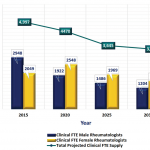“By 2030, there will be an excess demand for rheumatology care providers such that a doubling of the workforce would not be sufficient to meet the projected demand,” said Dr. Marcy Bolster, director of the rheumatology fellowship training program at Massachusetts General Hospital in Boston.
“It is imperative to create innovative ways to expand the rheumatology workforce, and this will involve new ways to fund graduate medical education training,” Bolster, an author on both studies, said by email. “While the workforce expansion cannot rely solely on increasing the number of fellows being training, this is an essential component of workforce supply.”
Beyond this, training efforts should also focus on enhancing the ability of primary care providers, nurse practitioners and physician assistants to help care for rheumatology patients, Dr. Sharad Lakhanpal of Rheumatology Associates and the University of Texas Southwestern Medical Center in Dallas, writes in an accompanying editorial.
Shifts in the way work is handled within individual medical practices might also help encourage some aging specialists to consider postponing retirement, Lakhanpal writes.
“The same aging demographic that will result in the increasing prevalence of rheumatic disease also pertains to the impending retirement of a significant proportion of the workforce,” Lakhanpal notes. “The generation of Baby Boomers and their children is proportionately larger than the generations that will follow, resulting in a shrinking workforce.”
Reference
- Bolster M, Bass A, Hausmann J, et al. 2015 Rheumatology Workforce Study: The Role of Graduate Medical Education in Adult Rheumatology. Arthritis & Rheumatology. DOI: 10.1002/art.40432


